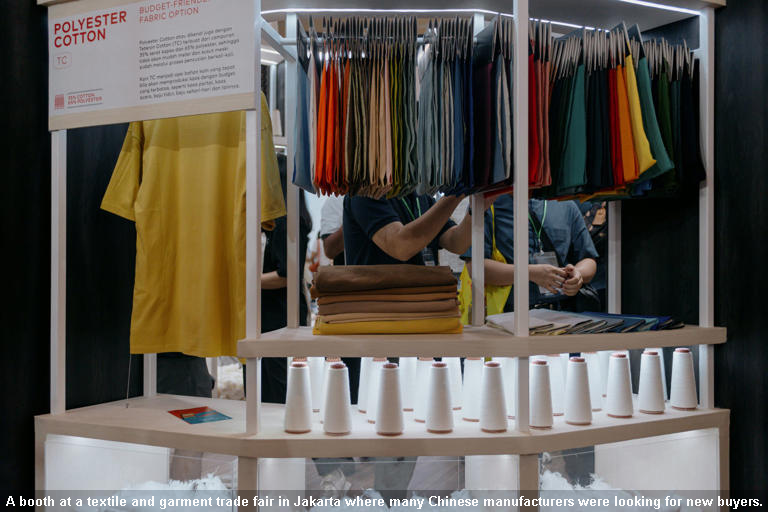
Category: General
Country: Indonesia
Region: Asia Pacific
By Hannah Miao
Dt. 27.04.2025
Reading time: 4 minutes
JAKARTA, Indonesia—Wang Chengpei runs a Chinese textile company selling polyester and nylon fabrics to garment manufacturers that make work and athletic wear. Until recently, about 30% of revenue at his company, Suzhou Feimosi Textile Technology, came from orders destined for the U.S.
Now, around a third of his buyers’ orders are on hold due to the U.S. tariffs on Chinese imports, and he is on the hunt for other markets. That has brought him to Indonesia, where he hopes to sell to local manufacturers.
“We came here to see if we can open up new markets” and make up for the loss of U.S. consumers, said Wang.
At a textile and garment trade fair this month in the Indonesian capital of Jakarta, he offered swatches of fabric with colorful designs that block ultraviolet rays, hoping they would appeal to local manufacturers making clothes for Indonesia’s tropical climate.
With the White House imposing 145% tariffs this year on Chinese goods, Chinese manufacturers are fanning out around the world in search of new markets to offload products that would have served U.S. demand.
It won’t be easy to find alternatives to America’s voracious consumers. The U.S. is by far the largest single-country buyer of China’s exported goods, accounting for roughly half a trillion dollars of products, or about 15% of China’s goods exports, last year, according to Chinese customs data.

The event pulled together manufacturers that sought to offer their products in the Indonesian market.
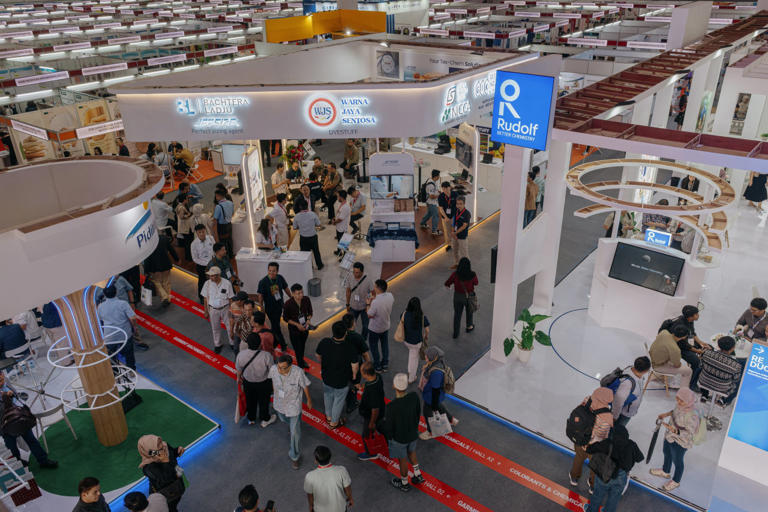
Chinese exhibitors outnumbered domestic manufacturers at the trade fair.
About a fifth of China’s goods exports to the U.S. have a high dependency on the U.S., Oxford Economics found.
At stake are about 10 million to 20 million jobs in China geared toward making products for American consumers, according to Goldman Sachs estimates. Also on the line is the health of the world’s second-largest economy.
Related video: Chinese Manufacturers Shifting Focus Due to U.S. Tariffs (Dailymotion)
Many Chinese manufacturers have little choice but to find new overseas markets for their goods, since they face brutal competition and a stagnating economy at home.
China’s leaders said they plan to boost domestic consumption and support tariff-hit sectors, and some e-commerce companies such as JD.com have announced initiatives to help exporters transition to the local market.
But demand from households and businesses in China is weak. After an epic property-market collapse and slowing economic growth, Chinese people are saving more and spending less. Consumer prices have flatlined, factory-gate prices have fallen for more than two years and imports have declined, a reflection of how tepid domestic spending is in China.
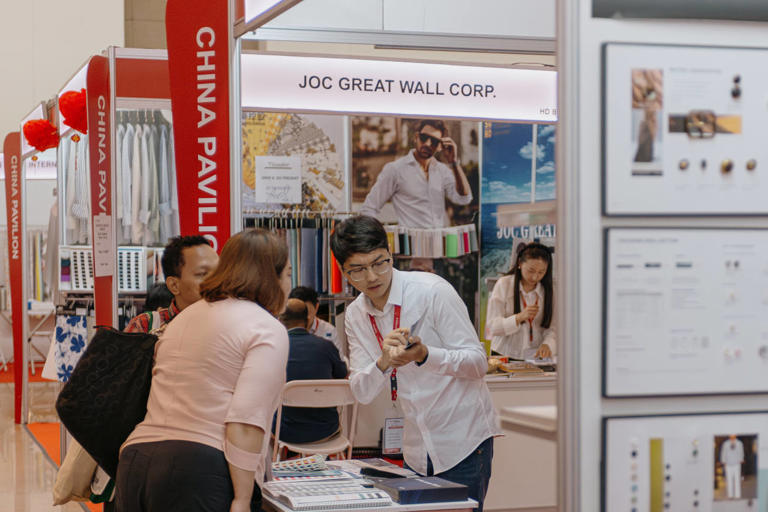
Many Chinese manufacturers have little choice but to find new overseas markets.
Qian Xichao, a representative of Wujiang City Hongyuan Textile, said he came to Indonesia for the fair for the first time because of how tough the domestic market is in China, where factories are churning out so many excess goods that price wars have broken out, killing profits.
“To be frank, personally speaking, all we can do is go out and look for new opportunities,” Qian said.
The European Union, the U.K., Vietnam, Taiwan, Malaysia, Indonesia, Mexico, Singapore, Saudi Arabia and Nigeria are the most likely to absorb Chinese exports previously bound for the U.S., according to Allianz. China’s exports to those countries could grow about 6% annually over the next three years, the firm estimates.
At the Jakarta trade fair, one of the largest for Indonesia’s textile and garment industry, Chinese exhibitors outnumbered domestic manufacturers by more than two to one in the directory. About 400 Chinese manufacturers were listed as exhibitors, and many said it was their first time in the country.
The squeeze on many exports to the U.S. is rippling to the Chinese manufacturers that produce fabrics, threads, yarns and other materials used to make clothing and other textile products. Some Chinese factory owners at the Jakarta trade fair said a portion of their production has already been suspended, and are bracing for a further slowdown in orders.
They are now on the hunt for new customers—and Indonesia, with its robust manufacturing sector and consumer market of around 280 million people, looks promising.
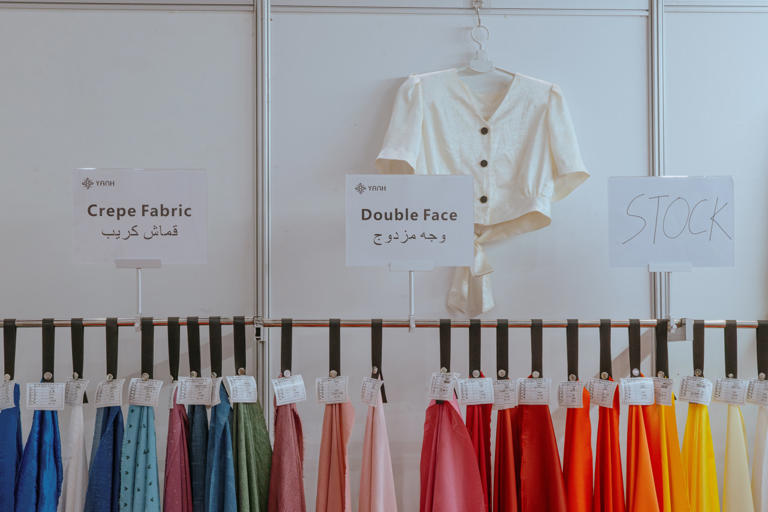
Signs for fabrics in Arabic and English.
The Chinese exhibitors could also piggyback off any boom in Indonesian textile producers selling to the U.S., given that the Trump administration’s proposed 32% tariff on Indonesian goods is lower than the duty on Chinese imports. Martin Sutanto, sales and marketing director for Indonesian fabric producer Fabriku, said he noticed an uptick in inquiries from agents for the U.S. market.
Still, some manufacturers say pivoting from the U.S. to other regions might not be so easy.
At the trade fair, many booths of Chinese manufacturers were sparsely attended compared with those of Indonesian exhibitors. Some salespeople were glued to their phones as few passersby stopped to check out their products.
Baoji Changxin Cloth, a Chinese exhibitor, displayed samples of thick cotton and polyester fabrics that could be difficult to sell in Indonesia’s climate.
Xi Ya, a manager at the company, said it was her first time in Indonesia and she noticed local buyers favored silkier fabrics.
“Our product may not match well in the market,” she said.
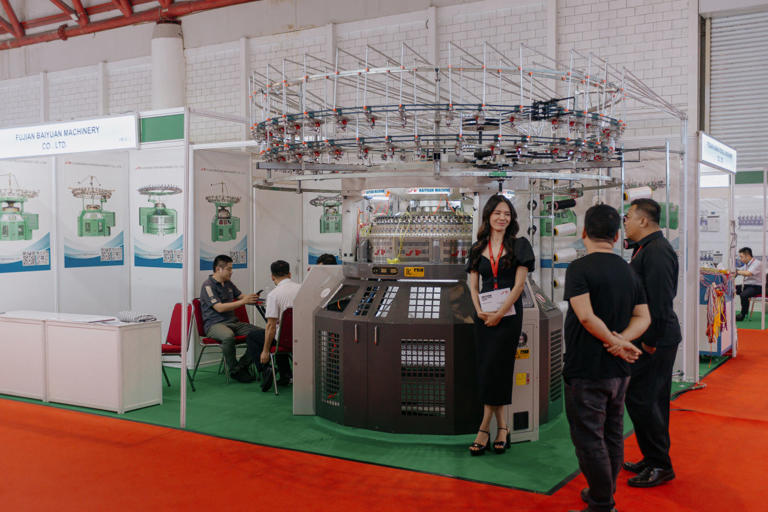
A squeeze on many exports to the U.S. is rippling to Chinese manufacturers.
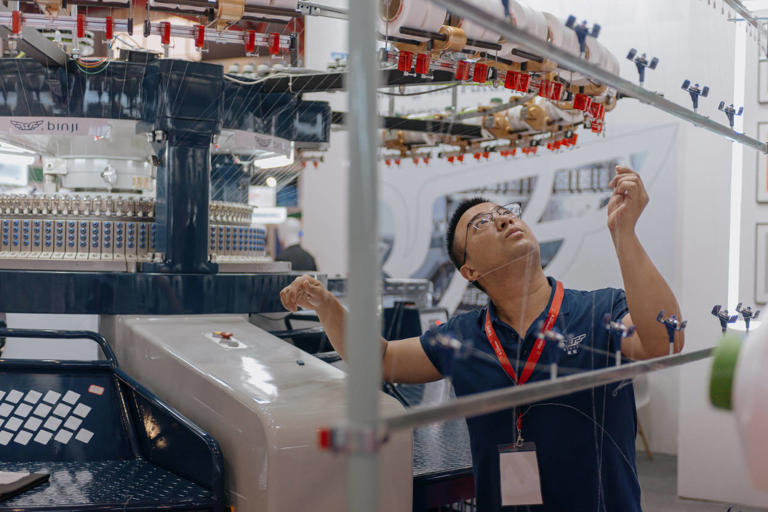
A technician adjusts threads on a knitting machine at the trade show.
Many manufacturers said they weren’t making big business decisions given how fast-changing the Trump administration’s tariff policy has been. Some are also exploring other consumer markets such as Europe, the Middle East and Africa.
“There’s nothing we can do about the tariffs. We’ll have to wait until the tariffs stabilize before proceeding, otherwise you wouldn’t dare take the risk,” said Michael Wang, a manager at Shaoxing Double-Color Textile.
Meanwhile, Sutanto, the executive at the Indonesian fabric producer, is worried about competing with a potential deluge of cheap goods from China if manufacturers there divert exports to Indonesia. Countries in Asia, Latin America and Europe have filed trade complaints against Chinese exporters that have sold cut-rate products in those markets.
“If China’s product floods the Indonesia market, that’s going to be hard for us,” he said.
Courtesy: msn.com
Copyrights © 2025 GLOBAL TEXTILE SOURCE. All rights reserved.